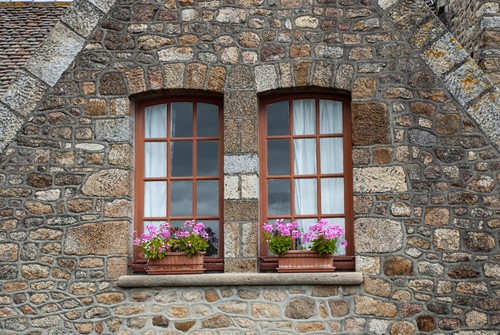
If your energy bills are high, your windows could be partly to blame. Windows allow the sun’s heat to warm up your home in summer, which means your air conditioner has to run more. Windows can let cold air in during winter through drafts while heated indoor air seeps outside, causing your furnace to run more. In fact, this loss and gain of heat through your windows can account for 25 to 30 percent of your energy bills. You’re more likely to have these problems if you have older windows. Replacing them with energy-efficient windows can help you use your heating and cooling systems less and save money on your energy bills. Keep these tips in mind for choosing energy-efficient windows.
The right window frames can improve the energy efficiency of your new windows. You should choose a material that offers higher thermal resistance, since this results in less heat loss. Vinyl, composite, fiberglass and wood frames all offer better thermal resistance overall, while metal or aluminum frames offer lower thermal resistance. Fiberglass frames, in particular, offer higher thermal resistance since they can be filled with insulation.
Energy-efficient windows sometimes have two or more glass panes rather than a single pane. The space between these panes provides insulation, which helps lower the window’s U-factor and SHGC. The U-factor refers to non-solar heat flow, while the solar heat gain coefficient (SHGC) refers to how much solar heat passes through the window. Windows with a lower U-factor have better energy efficiency. Windows with a lower SHGC can help homes stay cooler in summer, while a higher SHGC can help homes stay warmer in winter. The most suitable SHGC for your windows depends on your local climate and other factors.
Low-emissivity (low-e) coatings on windows provide more control over how much heat passes through the glass. These coatings lower the window’s U-factor and can also provide a low, medium or high SHGC as needed. Low-e coatings can increase the cost of energy-efficient windows, but they also help reduce energy usage, leading to lower energy bills throughout the year.
Gas fills and spacers can make windows even more energy-efficient. Spacers help improve the performance of glazing by making sure different layers of it are correctly distanced. Gas fills, such as argon and krypton, help keep heat transfer between the outer and inner layers of a window to a minimum. This helps keep solar heat from warming up your home in summer and reduce the loss of heated air from inside your home in winter. Krypton offers a better thermal performance, while argon typically costs less.
The types of windows you choose for your home can affect their efficiency. Some types of windows offer better energy efficiency than others. For example, single-hung and double-hung windows usually have higher air leakage, making them less energy-efficient. Casement, awning and hopper tend to have lower air leakage, which makes them a better choice for reducing energy usage. Air leakage allows hot air inside in summer and cold air inside in winter, which can lead to higher energy bills as your air conditioning and heating need to run more often. Choose windows that are known for having lower air leakage to ensure greater energy efficiency.

Meet the team of Your SWFL Real Estate Experts ~ Melinda Leake and Kelly Henderson. Our business is guided by faith & built with integrity. Whether you're buying or selling, you'll benefit from having this team of professional REALTORS by your side.